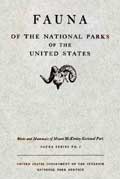.gif)
MENU
|
Fauna of the National Parks — No. 3
Birds and Mammals of Mount McKinley National Park |

|
Birds
DESCRIPTIONS OF BIRD SPECIES
AMERICAN PIPIT
Anthus spinoletta rubescens [TUNSTALL]
GENERAL APPEARANCE.—A slender grayish ground-inhabiting bird with fine breast streaks of brownish-gray. It has a slender warbler-like bill and a long claw on the hind toe. It is similar in habits and in general outline to the horned lark. Length, 6.38 inches.
IDENTIFICATION.—It lacks the black ear tufts and black facial and throat markings of the horned lark yet it is similar to it.
DISTRIBUTION.—It breeds in the Arctic Zone from Siberia, northern Alaska, and Greenland south to Oregon, Colorado, and New Mexico. It is found in the higher passes throughout the McKinley region.
HABITS.—On May 20, 1926, high up amid the vanishing snowfields on a rocky barren ridge at 4,000 feet, we watched a male pipit in full nuptial flight. It perched on a rock, then flew almost vertically into the sky for a distance of from 50 to 150 feet, singing a single note which was repeated constantly. Then with legs extended, feet spread out, and tail sticking upwards at a sharp angle, this male bird sang steadily as he fluttered his wings and floated down like a falling leaf, usually landing near the place from whence he began his flight.
On June 18, 1932, at Sable Pass, I examined a pipit nest that contained five eggs. Incubation had just begun. This nest was placed on the ground under a shelving overhanging bank and was made of fine grass blades and plant fiber.
On June 27, 1926, at the head of Savage River, we found a young bob-tailed pipit just out of the nest. As it was scarcely able to fly we caught it easily.
At 5,000 feet altitude near Anderson Pass and the Muldrow Glacier we found three pipits feeding with two Hepburn's rosy finches at the edge of a melting snowbank on July 15, 1926.
This species breeds throughout the McKinley region in the mountain passes and along the barren ridges high above timber line. They appear to be but slightly discouraged from breeding because of heavy snowfall and late spring snowstorms. Since they place their nests under protecting rocks they are independent of the weather to a certain degree. They are regular and common breeders in Mount McKinley National Park.
NEXT >>>
 Top
Top
Last Modified: Thurs, Oct 4 2001 10:00:00 pm PDT
http://www.cr.nps.gov/history/online_books/fauna3/fauna9j8.htm
![]()
